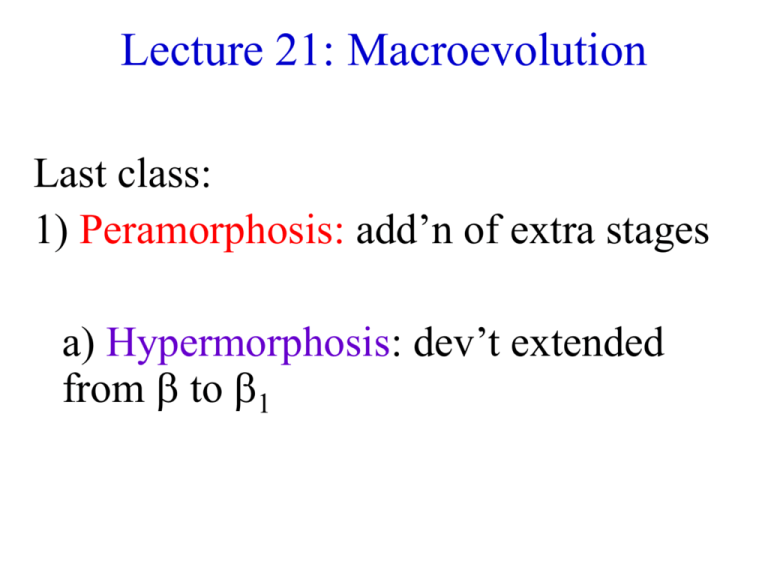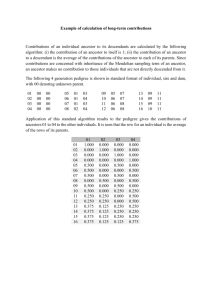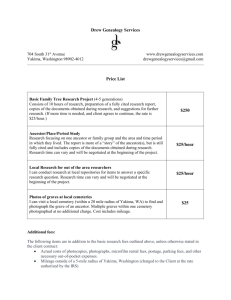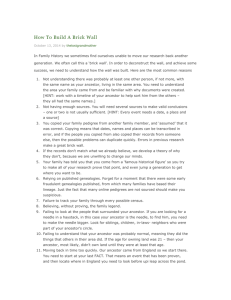Lecture 21: Macroevolution
advertisement

Lecture 21: Macroevolution Last class: 1) Peramorphosis: add’n of extra stages a) Hypermorphosis: dev’t extended from to 1 b) Predisplacement: y starts growing early rel. to x in descendent vs. ancestor log y 1 1 log x Descendant Ancestor - same allometry (relationship of y to x) - early start of y means greater y (not x) at maturity c) Acceleration • faster growth of y rel. to x in descendent vs. ancestor Descendant 1 log y Ancestor Larger (or more dev’d) y (not x) at maturity log x 2) Paedomorphosis • retention of juvenile features in adult A) Progenesis B) Neoteny C) Postdisplacement a) Progenesis • dev’t stops early log y 1 log x Ancestor Descendant Smaller y, smaller x at maturity vs. ancestor - Allometry unchanged - Compare: hypermorphosis b) Neoteny • slower rate of growth of y rel. to x in descendant vs ancestor log y 1 log x Ancestor Descendant - Smaller or less developed y rel. to x at maturity c) Postdisplacement log y • y starts growing late rel. to x in descendant vs. ancestor 1 log x Ancestor 1 Descendant - same allometry - late start of y means smaller y (not x) at maturity Paedomorphosis Peramorphosis underdevelopment Rate overdevelopment Slower Faster (Neoteny) (Acceleration) Onset Time Later Earlier (Postdisplacement) (Predisplacement) Offset Time Earlier Later (Progenesis) (Hypermorphism) Evolutionary Significance of Heterochrony? 1. Large changes in phenotypes easily accomplished - mutations at one or several loci may be involved 2. Likely important in speciation - gene pools w diff. heterochronic mutations repro. isol’n 3. May release lineages from phylogenetic constraints - e.g. paedomorphosis: descendant no longer passes through the same develop’l stages as ancestor - can “free” the sp. from the constraint imposed by that structure - only affects existing structures. Genetic Basis of Heterochrony Homeotic (Hox) genes: • 1st discovered in Drosophila spp. • involved in gross alterations in phenotype • Affect develop’t of cuticular structures from imaginal disks • in all animal phyla • share # of common characteristics • e.g. antennapedia Hox Genes 1. organized in gene complexes - probably involves gene duplication 2. spatial & temporal collinearity: - 3' end expressed anterior; 5' end expressed posterior - 3' end expressed earlier in dev’t than 5' end Hox Genes cont’d 3. contain highly-conserved 180 bp region - involved in binding Hox genes are regulators - control timing and expression of other genes e.g. Ubx (ultrabithorax) in Drosophila: controls expression of 85 - 170 genes Type of Heterochronic Process? Axolotl vs. Tiger Salamander • failure to metamorphose • [thyroxine] : can be exp’tally induced • external gills in adult (juvenile morphology) So what’s going on? • not postdisplacement : age at maturity ≈ other salamanders • not progenesis : body size at maturity ≈ other salamanders (progenesis tiny adult) • Neoteny: somatic dev’t slows & is overtaken by normal sexual maturity giant juvenile D’Arcy Thompson • early 20th century • comparative anatomist • “On Growth & Form”: transformation grids: explain changes in shape & determine allometric growth • measurements made & plotted on rectangular coordinates • same measurements made in a related organism or a different stage in dev’t • shown as deformations of grid system • now : partial warp analysis Hatchetfish Wrasse & Angelfish Skulls of Human, Chimp & Baboon Evolution of Higher Taxa (Gould) • new groups often arise from neotenic or progenetic ancestors • e.g. flightless birds • e.g. insects: from larval form of millipedelike ancestor? • e.g. chordates larval cond’n of tunicates? Saltationists • distinctive features of higher taxa arise through “systemic mutation” (complete reorganization) • Argument: - few intermediates among higher taxa - little selective advantage to incipient structures - results in dramatic, discontinuous effects Neodarwinists Counter-argument: - characters of higher taxa evolve mosaically - many intermediate forms e.g. Archaeopteryx, Lepidoptera - early stages of complex structures selectively advantageous - mutations with disruptive pleiotropic effects usually fatal (no change in rate)






